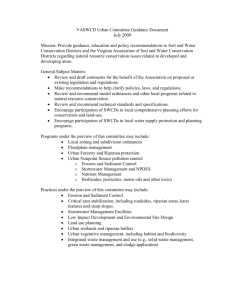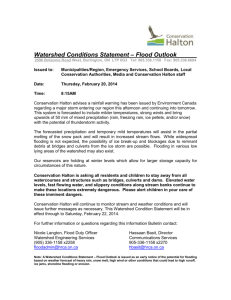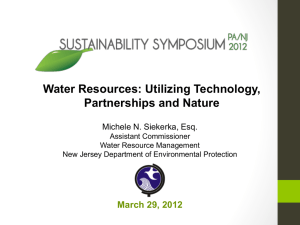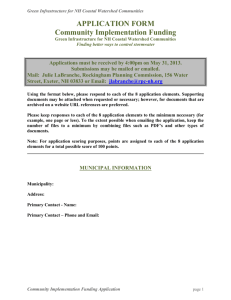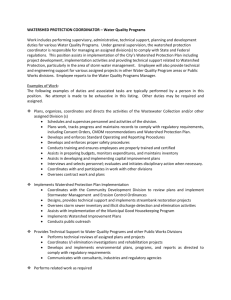Word
advertisement
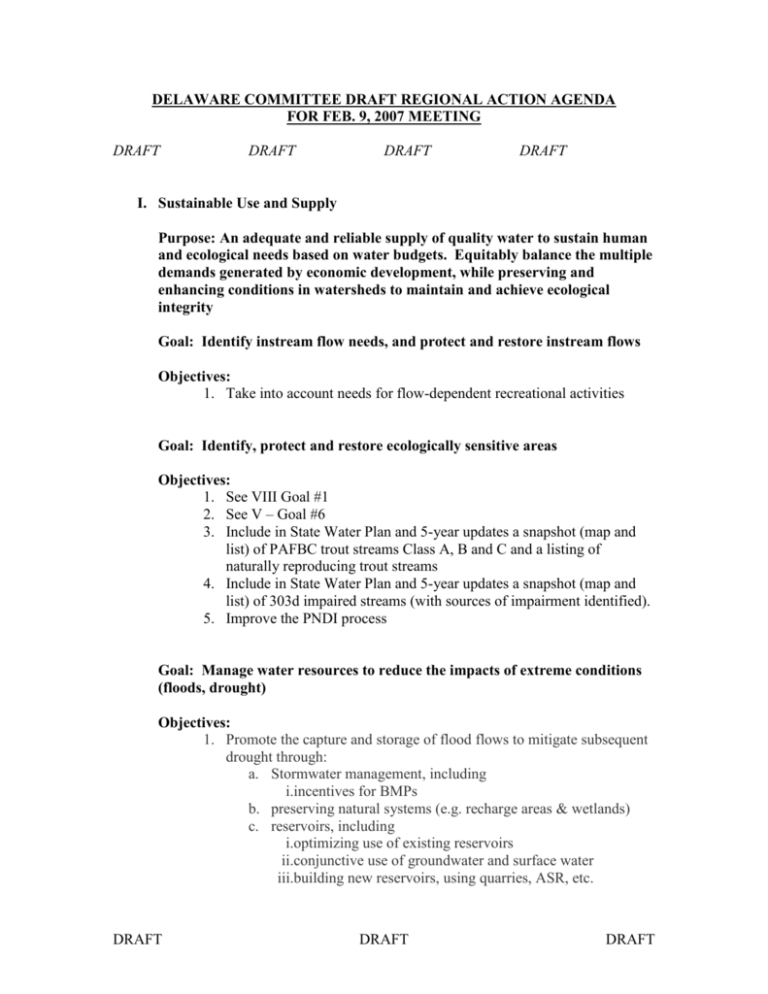
DELAWARE COMMITTEE DRAFT REGIONAL ACTION AGENDA FOR FEB. 9, 2007 MEETING DRAFT DRAFT DRAFT DRAFT I. Sustainable Use and Supply Purpose: An adequate and reliable supply of quality water to sustain human and ecological needs based on water budgets. Equitably balance the multiple demands generated by economic development, while preserving and enhancing conditions in watersheds to maintain and achieve ecological integrity Goal: Identify instream flow needs, and protect and restore instream flows Objectives: 1. Take into account needs for flow-dependent recreational activities Goal: Identify, protect and restore ecologically sensitive areas Objectives: 1. See VIII Goal #1 2. See V – Goal #6 3. Include in State Water Plan and 5-year updates a snapshot (map and list) of PAFBC trout streams Class A, B and C and a listing of naturally reproducing trout streams 4. Include in State Water Plan and 5-year updates a snapshot (map and list) of 303d impaired streams (with sources of impairment identified). 5. Improve the PNDI process Goal: Manage water resources to reduce the impacts of extreme conditions (floods, drought) Objectives: 1. Promote the capture and storage of flood flows to mitigate subsequent drought through: a. Stormwater management, including i.incentives for BMPs b. preserving natural systems (e.g. recharge areas & wetlands) c. reservoirs, including i.optimizing use of existing reservoirs ii.conjunctive use of groundwater and surface water iii.building new reservoirs, using quarries, ASR, etc. DRAFT DRAFT DRAFT 2. In coordination with Waterways Corridor Management goals, promote improved flood plain management: a. Promote the use of public funds (FEMA, open space funds, etc.) to acquire properties vulnerable to flooding and convert the properties to open space or low-risk use; b. Identify and track the acreage of land in flood ways and flood plains that is permanently preserved as open space. c. Identify, quantify and track the value of properties vulnerable to flood damage d. Track injuries and fatalities caused by flooding i.Support the continued development and expanded use of AHAPS and other flood warning systems e. Track local implementation of effective flood plain ordinances f. Improve accuracy of flood plain mapping 3. Establish practices to reduce the impacts from drought by promoting water supply reliability and conservation, by: a. Encouraging (and removing obstacles to) the pricing of water to reflect full cost recovery and scarcity. b. Promoting stronger reliability of water supply infrastructure by identifying opportunities for water suppliers to interconnect stand-alone systems, especially to augment or replace unreliable source water supplies. Goal: Provide an adequate supply of potable water for public and private water supplies and suitable water for commercial, industrial, agricultural and power generation needs Objectives: 1. Encourage drinking water utilities to compile regular water audits of their supply operations 2. Measure and control water system leakage and loss 3. Identify specific alternatives to provide for existing and projected future water demands identified in the State Water Plan for commercial, industrial, agricultural and power generation needs. Goal: Encourage water conservation, recycling and reuse Objectives: 1. Make the Water Conservation Technical Assistance Center an effective vehicle for promoting water conservation c. Provide funding, staff, and a physical presence within DEP d. Task the WCTAC with developing partnerships with representatives from water use sectors (e.g. water suppliers, DRAFT DRAFT DRAFT golf courses, farmers, nurserymen, electric power generators, manufacturer, etc. e. Task the WCTAC with developing partnerships with national organizations and initiatives (e.g. EPA “water sense” program; Alliance for Water Efficiency, California Urban Water Conservation Council). 2. Identify performance indicators (e.g. median residential water consumption [annual average and peak month]; consumptive water use per kilowatt hour of power generated; peak month consumptive water use per irrigated acre on golf courses) Goal: Use and promote sound data gathering, data management, data sharing and consistency Objectives: 1. Recognize and account for all significant water withdrawals Goal: Encourage local/county/regional plans consistent with the State Water Plan Objectives: 1. Identify existing laws and regulations that currently specifically reference the State Water Plan, and cite any current legal requirements for consistency. 2. Identify minimum policy and methodology requirements for local/county/regional plans (including Act 167 and Act 537 plans) to be deemed consistent with the State Water Plan. 3. Identify opportunities for incentives (and disincentives) to encourage consistency of local/county/regional plans with the State Water Plan. Goal: Identify the roles of various agencies (e.g. DRBC, DEP, PUC, DCED, PEMA, CCD, PennDOT) in implementing the State Water Plan Objectives: 1. Identify existing laws and regulations that currently specifically reference the State Water Plan. 2. Outline the contact procedure and which agency takes the lead in the permitting process. 3. Reference specific goals and objectives in the State Water Plan to agencies with responsibility/authority for implementation; provide description of agencies, summary of existing legislative and regulatory authorities and obligations, and web links in a separate appendix. 4. Improve communication and coordination among agencies implementing the State Water Plan. DRAFT DRAFT DRAFT Goal: State infrastructure investments should be consistent with the State Water Plan Objectives: 1. The State Water Plan should identify areas where this consistency will promote sustainable use and supply of water resources II. Recommendation on Education and Involvement for Stewardship Purpose: DEP should develop a program for education and involvement for stewardship to: Goal: Ensure that principles embodied in the State Water Plan are incorporated in state environmental education curricula and watershed organization education programs in cooperation with County Conservation Districts Objectives: Goal: Promote use of DEP tools and principles of sustainable use and supply among developers, engineers and planners Objectives: Goal: Promote consistency with the State Water Plan in local planning through activities like PSATS courses Objectives: III. Linking Land and Water Resource Management Purpose: The integrated management of land and water resources to sustain the quality of life in the Basin; preserving, restoring and enhancing ecological resources while recognizing the community's social and economic relationships to these resources Goal: Provide data analysis tools to support consistent links between land use and water resources planning for local governments. Objectives: Require or recommend that data collection be consistent with DEP’s WAVE tool from all who collect water quality and quantity data (including volunteer monitoring data). Require/enable DEP to make the WAVE tool widely and easily available via the Internet for local governments and the public. Make the USGS screening tool available (via an application process) for municipalities and watershed groups to analyze the impacts of significant new DRAFT DRAFT DRAFT development projects. In the long term, DEP should make the screening tool available via the Internet for use in analysis of proposed projects. Goal: Increase awareness among municipal officials about links between land use and water resources and provide resources that promote programs that link land use and water resources. Objectives: Educate elected and appointed municipal officials, municipal engineers and solicitors and planning consultants via appropriate trade associations (PSATS, PMAA, PA Borough Association, League of Cities, PBPE, PBA, PPA, NGWA, AWWA and others) and through continuing education programs for professionals. Work with public and private colleges and universities to incorporate issues and tools related to the link between land use and water resources into their curriculum. Involve other state agencies, including the Dept. of Community & Economic Development, to provide materials and training to municipal officials. Goal: Increase public awareness about the links between land use and water resources. Objectives: Make the link between land use and water resources part of the educational curriculum in Pennsylvania’s schools, incorporating the concept into the science and ecology standard. Enlist a variety of stakeholders and institutions to help educate the public, including: watershed associations, land trusts and conservancies; water authorities and community water systems; radio and television stations and newspapers; associations of well owners; PA Rural Water Association and Water Resources Education Network; PA Center for Environmental Education; Chambers of Commerce. Goal: Implement sound stormwater management. Objectives: Promote infiltration and other recharge technologies. Retrofit old existing systems. Require sound stormwater management in new developments. Require sound stormwater management during redevelopment. Improve the technical ability of municipalities to review development proposals and stormwater management plans. Goal: Control nonpoint source pollution from agriculture, mining, quarrying and abandoned mines, and forestry. Objectives: Agriculture: o Extend CREP into the Delaware Basin. o Expand ACRE funding into the Delaware Basin. o Partner with the Farm Bureau and the Grange to educate farmers about strategies to reduce runoff. DRAFT DRAFT DRAFT o Encourage farms applying for or in farmland preservation programs to use Best Management Practices to reduce nonpoint pollution. Mining/Quarrying and Forestry o Encourage development of model ordinances to promote mining and forestry practices that reduce runoff, working in cooperation with the Bureau of Mining, Department of Agriculture and Department of Conservation and Natural Resources. o Promote funding for the installation, operation and maintenance of AMD remediation projects in the Delaware Basin, particularly for the clean up of AMD contaminated streams. Add innovative technology grants for AMD remediation. o Extend TreeVitalize beyond 2007. Goal: Identify, protect and restore high value water resource areas – wetlands, floodplains, groundwater recharge areas, erodible slopes, headwater streams and associated drainage area, forested areas, and water bodies. Objectives: Develop an improved common database of digital maps, promoting the sharing of inventories in a consistent way. o Support continued funding of the PMAP program and other associated projects in order to develop a common data pool of maps and resource inventories. o Promote sharing of information in a consistent way, compiling public and private data into a common repository. o Encourage municipalities to develop natural resource inventories and encourage County Planning Commissions (or other regional bodies as appropriate) to collect and maintain these inventories. Assist counties and municipalities in disseminating information on high value water resource areas and developing tools to protect these resources. o Educate municipalities on appropriate tools for disseminating information and protecting the resources. o Develop model ordinances to protect high value water resource areas for adoption by local governments. Develop state incentives and disincentives for protecting these resource areas. o Do not provide public funding for project that would negatively impact these high value water resource areas. Goal: Reduce point source discharges of toxics and wastewater and promote land application and appropriately scaled wastewater treatment systems. Objectives: Investigate the impacts of regional wastewater treatment plant systems on dewatering watersheds and the impact of discharges from treatment plants on small headwater streams (in order to avoid creation of effluent dominated streams.) Encourage, and if possible, require, consideration of more regional approaches to land application of treated wastewater. DRAFT DRAFT DRAFT Reduce Combined Sewer Overflows and Infiltration and Inflow in wastewater treatment systems. Consider the overall health of a watershed in permit decisions in order to ensure that the cumulative impact of NPDES permits in a watershed do not negatively impact its designated use. Research the impact of multiple NPDES permits on a watershed and the process of setting limits to determine if a problem exists. Goal: Coordinate public infrastructure investments with sound water resource planning. Objectives: Integrate transportation plans with water resource and land use plans. Address transportation issues such as spills and releases. Address economically sound and environmentally viable solutions for water supply and sewage disposal in subdivisions. Goal: Discourage development where it may impair water resources and their related natural resources; encourage reuse and infill development where water and wastewater infrastructure exist; encourage design of new development in a way to reduce environmental impact. Objectives: Goal: Link sewage facilities planning with water resource planning, strengthen statutory authorities, and provide better training for municipalities. Objectives: Goal: Amend the Municipalities Planning Code to allow local governments to address more effectively water resource issues. Objectives: Clarify and if needed, expand municipal authority to consider water quantity issues in land development applications, including allocations for future needs. Expand state and municipal authority to regulate the quality and volume of stormwater runoff (not just peak rate) in land development and re-development applications. Ensure that water quality, water quantity and stormwater management are considered as part of comprehensive plans. Require plans for water supply to be tied to land development plans; tie to review of wastewater management plans as well. Ensure that DEP has authority to deny permit applications based on water supply and wastewater management concerns. Goal: Coordinate with and help define the role of DRBC, DEP, PUC, DCED, PEMA, CCD and PennDOT in water resource planning. Objectives: DRAFT DRAFT DRAFT Ensure that River Basin Commissions have sufficient authority to consider land use issues and future water use needs in reviewing water use applications. IV. Waterway Corridor Management Purpose: Waterway corridors that function to support healthy aquatic and riparian ecosystems, preserve natural stream channel stability, protect property and floodplain ecology, minimize flood-induced loss of life, and provide appropriate recreational access. Goal: Identify, protect, conserve and restore healthy and biologically diverse riparian and aquatic ecosystems. Objectives: Identify the needs of riparian and aquatic ecosystems. Provide corridor mapping for the preservation of habitat Educate the public, especially children, about the importance of protecting water resources and waterway corridors Incorporate the protection of riparian corridors into local ordinances. Encourage farmers to maintain riparian buffers, riparian fencing and other conservation activities through the county conservation districts Promote the adoption of water resource ordinances and growing greener ordinances Incorporate ecosystem requirements into water quality criteria and flow targets Action Items: Provide funding for counties and municipalities to develop water resource ordinances, ordinances recognizing transfer of development rights and growing greener ordinances Provide mechanism for county ordinances to govern if municipalities do not adopt such ordinances Provide incentives to farmers for establishing riparian buffers, riparian buffers, fencing, stormwater management and other conservation activities through the county conservation districts Enhance and promote the CREP program Provide water credits to farmers in times of drought that have reached certain conservation thresholds Goal: Identify, protect and restore floodplains, buffers and wetlands to healthy, natural function which will protect ecosystems, property and life. Objectives: Provide accurate mapping of floodplains and floodways DRAFT DRAFT DRAFT Encourage the use of riparian buffers, recognizing that they may be different in developed versus undeveloped areas In the redevelopment of brownfields, encourage greater pervious surfaces, greater infiltration and buffers and provide incentives for going beyond the minimum Goal: Enhance appropriate water-based recreation in and along the Delaware River and its tributaries. Objectives: Provide access areas along the Delaware River and its tributaries Action Items: Provide additional funds to DCNR and Fish and Boat Commission for funding the acquisition of open space and creation of access points along waterway corridors. Provide funds for alternative modes of transportation - walking trails and bike paths -along waterways. Goal: Secure needed legislation and regulation to accomplish protection and restoration of floodplains, buffers, wetlands and appropriate water-based recreation. Objectives: DRAFT DRAFT DRAFT
